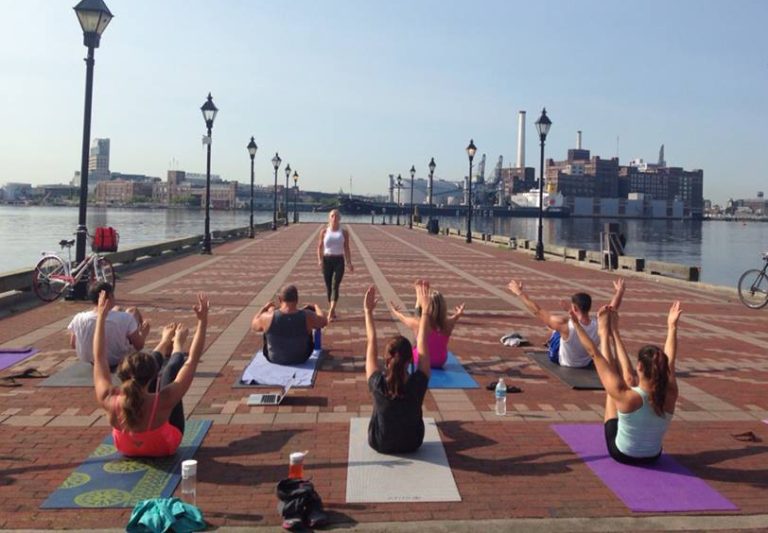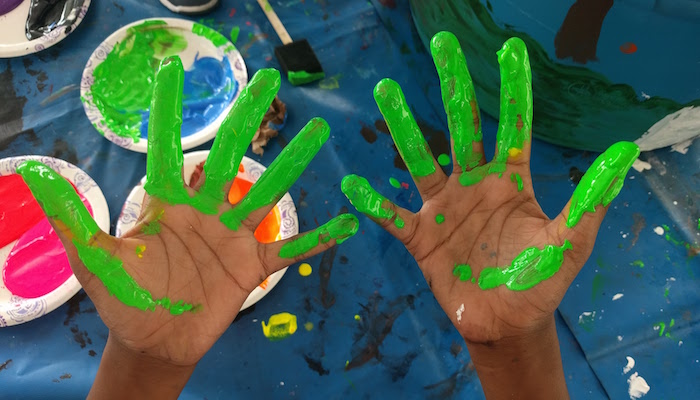Working Together to Improve Water Quality – An Interview with Fiona Newton
After leading Blue Water Baltimore for almost four years as our Board Chair, Fiona Newton is passing the torch to Kevin Shea in January 2019. We sat down with Fiona to talk about her journey with our organization, what she sees for the future, and what people might be surprised to know about her.
How did you first get involved with Blue Water Baltimore?
I moved to Baltimore from the United Kingdom in 2003 to work as a fundraiser at the Johns Hopkins Bloomberg School of Public Health. Through my work there, I learned about the work of Hopkins researchers, like Dr. Ellen Silbergeld, who were examining the bacterial contamination of fish caught in Baltimore’s rivers and harbor. Additionally, I was alarmed to see the amount of trash that swept down the Jones Falls river each day into the harbor. My eyes had been opened, and I could not close them again. I felt the need to do something, so I began to volunteer with the Jones Falls Watershed Association (JFWA) at one of their Saturday trash clean-ups along the river bank. When JFWA board chair, Sandy Sparks, discovered I was a fundraiser at Hopkins, she asked me to join their board to help with fundraising. The JFWA was one of 5 small watershed organizations that then merged in 2010 to become Blue Water Baltimore. I was asked to be one of the inaugural members of the board of directors for the new organization, and have been on the board ever since.
What’s one of your favorite memories during your time on the Board of Blue Water Baltimore?
I have so many! Most of my favorite moments involve time spent with Blue Water’s amazing board members, staff, supporters, partners, and members of our local communities. Just this week, I attended Photovoice, a photography and arts event in the Cherry Hill neighborhood, organized by Blue Water’s education and outreach program in collaboration with Youth Resiliency and the Cherry Hill Community Association. What a great example of groups of people coming together to inspire and get to know each other and discover how we can work together to improve the local environment.
I greatly enjoy Blue Water Bash, our biggest fundraiser of the year, because there’s nothing better than socializing with 400 like-minded people who care about Baltimore’s waterways. Mayor Pugh spoke at this year’s Bash and endorsed Blue Water’s efforts in her remarks. That was certainly a highlight.
Another favorite memory is when the Blue Water Baltimore headquarters moved from Belair-Edison to our new, larger location on Sisson Street in Remington in the Spring of 2017– a move that symbolized the growth and increased impact of our organization.
But I have been most impressed by touring Blue Water’s stormwater restoration projects. I have heard firsthand from partner organizations how they have been able to mitigate stormwater runoff on their properties thanks to guidance and construction support from Blue Water’s talented staff. On our last tour, we saw a system of giant metal barrels managing rooftop stormwater runoff at a local church, community rain gardens diverting stormwater off a shopping mall’s parking lot, as well as bioswales and native plantings in a city park.
What have you enjoyed the most about being the Board Chair?
Again, it’s hard to choose just one thing. I enjoy being a strategist and a facilitator. So, I would say that I’ve enjoyed overseeing the strengthening of the organization and its leadership structure, ensuring we have a strong Executive Director and knowledgeable board members. I have tried to stay focused on the big-picture perspective – continually asking: what will make Blue Water Baltimore more effective and sustainable for the future? How can we work better to meet the needs of local communities? How can we partner more effectively? I’ve also been fortunate to work with Jenn Aiosa, our Executive Director, and have really appreciated seeing her take the helm with her positive, can-do attitude, while bringing a very solid background in environmental science and advocacy to the organization. She has energy, enthusiasm, and drive in abundance!
What kind of changes have you seen both with Blue Water Baltimore and Baltimore City over the past 8 years?
For Blue Water, there has been an increase in the scale and complexity of the organization and the projects that we undertake. For example, the Jones Falls stream restoration project in 2017, just off Falls Road, is an example of Blue Water collaborating with others to improve the river’s natural habitat and water quality. Meanders were reintroduced along some 500 feet of the river to slow down the flow and has resulted in improved habitat for fish and wildlife – there were even trout sightings last summer slightly upstream. Our current green infrastructure installation in collaboration with Medstar Harbor Hospital, just south of the Hanover Street bridge, is our biggest ever stormwater management project. Both projects were big firsts for us, requiring us to adapt operationally and necessitating our move to the bigger headquarters building so we could house our vehicles, equipment and tools, as well as a larger staff.
I’ve been pleased to see an increased conscience in Baltimore in terms of environmental stewardship as well as greater interest in climate change, environmental justice and water quality. Overall, I feel there is a greater awareness of environmental issues in our area. Today it is gratifying to see the Waterfront Partnership’s Mr. Trash Wheel, sitting at the mouth of the Jones Falls. It draws attention to trash issues and the need for all of us to do more to protect our environment.
It has also been gratifying to see Baltimore City’s renewed investment and commitment, under the leadership of Rudy Chow, Director of the Department of Public Works, to upgrading the city’s sewer infrastructure. When these complex engineering projects are accomplished, we expect to see a measurable improvement in water quality in the Jones Falls and the Inner Harbor, and Blue Water will be monitoring progress of these projects closely.
What do you think will change about Blue Water Baltimore over the next five years?
Our new five-year Strategic Plan will launch in January 2019. I see Blue Water Baltimore as consolidating, but not necessarily changing, as we build on our successes to date. We will be looking to ensure our water quality monitoring, advocacy and restoration work is strategic and effective across the Gwynns Falls, Jones Falls, Herring Run, and Baltimore Harbor watersheds, and will expand our education and outreach program. We will seek more opportunities to partner with other organizations in order to make a greater impact on improving water quality by working together.
What would you say are some of your strongest beliefs about Blue Water Baltimore’s mission?
I support Blue Water Baltimore because we take a holistic approach to improved water quality.
Some of our local environmental problems are very entrenched and no one factor is responsible for poor water quality. It’s vital to understand that clean water is ALL of our responsibility and each of us can make a difference. We can reduce polluted runoff from our own homes, businesses, and organizations; we can be careful about what we put down our drains; we can plant trees and native plants to act as buffers to absorb stormwater; we can advocate for improved laws to protect our waterways. Blue Water’s new Strategic Plan will focus us and ensure we are making the most impact with the resources we have available.
Is there someone who has influenced you either before or during your time at Blue Water Baltimore?
The late Dr. Michael Beer, who was the former chairman of the Department of Biophysics at Johns Hopkins University and a co-founder of the Jones Falls Watershed Association, was an inspiration to me. For many years, he was a visionary and champion for Baltimore and its waterways. He pioneered the first Rally for the River, when we shut down the Jones Falls Expressway so that people could appreciate the river running beneath the expressway. He had great drive and determination, and taught me that if we all pay attention to the environmental challenges within our own communities, and resolve to take action, then everyone can do something meaningful to improve our surroundings and quality of life. Along with many others, I am determined to continue Michael’s legacy of bringing people together to achieve more for the environment and public health than any of us can do alone.
What are your thoughts on the importance of volunteering?
My job at Johns Hopkins University focuses on improving the engagement and stewardship of donors and volunteer leaders. I have worked in the nonprofit sector for nearly 30 years, and have seen many examples of the immense value that volunteers bring to an organization and the sense of achievement that volunteers have when they truly make a difference through their efforts. Volunteers are a vital resource, and need to be organized and managed thoughtfully to ensure their experience is meaningful to them and has the desired impact for the organization and its mission.
Personally, I want to use my time by being valuable to society, by helping to improve our environment. Volunteering is very rewarding in that respect – it feels tremendously worthwhile. And it’s not all hard work. I enjoy the social side and having an incredible network of friends who care about Baltimore’s waterways as I do.
What do you do when you aren’t working/ volunteering?
I adore gardening, although I struggle with this mid-Atlantic climate and the invasive plants here. I have been slow to adapt from my experience with cottage gardening in the UK! I also enjoy hiking, kayaking, and travelling. My husband, Eric Johnson, and I seek out islands to explore when we travel. We recently spent time on the stunning Galiano Island off the coast of Vancouver Island in British Columbia.
What might someone be surprised to know about you?
I practice tai chi, including tai chi sword and fan forms. I’ve studied tai chi for over 20 years and teach it here in Baltimore in my spare time. It helps me stay fit, calm and relaxed. Eric runs Baltimore Tai Chi, and we met in 2002 at a tai chi workshop in Nijmegen in the Netherlands.
What do you look forward to the most over the next few years?
I will serve on Blue Water’s Board for another year and help implement our Strategic Plan under the leadership of our new board chair, Kevin Shea. Beyond that, I will most certainly continue to be a champion for Baltimore’s waterways and do whatever I can to help achieve clean water. And, of course, I will still be an enthusiastic supporter of Blue Water Baltimore!



